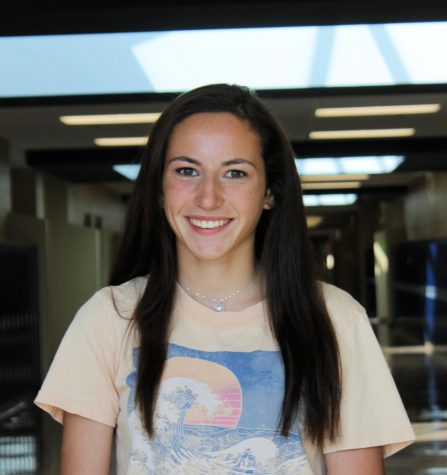More than just a horse girl
Sophomore Emma Peterson shares her stories of working in the horse racing industry
Getting acquainted: Peterson pats her filly on the nose. These two have formed a spunky bond as they work together. (Photo Courtesy of Sharon Dixon)
November 1, 2018

The sharp patter of hooves on dirt cause the dust to rise in a swirling vortex off of the dirt track. All four legs propel the 1200 pound horse off the ground and towards the finish line. The announcer’s voice rises to a crescendo as the glossy brown animal flies across the line.
This is American Pharaoh, winning his fourth race and the Triple Crown. After watching American Pharaoh win the triple crown in 2015, Peterson was officially hooked. Horse racing drew her in and she soon became the first in her family to be involved in the industry. After the interest took hold of her, she received her own horse, Dexter, for Christmas. Since then she has bonded with the animal and many others.
“The filly I work with is spunky and energetic and quirky, and I connect with her in that way,” sophomore Emma Peterson said.
Peterson currently works as a manager of a racehorses’ career. This means she works hard to market the horse; find trainers for the horse, find jockeys, and investors.
“[My coach’s] job is to give me direction in what to do, he gives me institutions and I go and do it- kinda like homework; fun homework in my case,” Peterson said.
Horse meets take place mostly from February to May. Horses specialize in different distances and can race on different surfaces. The uniqueness and clean-cut sport draws many jockeys, trainers and spectators.
“That ‘purity of the sport’ is one of the things that attracts me to racing. No judges or style points, just a horse, a rider, and a finish line,” owner and breeder of the filly Peterson works with, Dan Dixon said.
Currently she is working with a Thoroughbred filly. The filly’s training can last anywhere from 8-10 months and up to 2-3 years. Throughout the whole process Emma will carry investors and partners through the journey.
“She’s learning to develop her own writing and photography skills which will serve her well as she provides the partners with meaningful insight into the progress of their horse,” Dixon said.
The hours spent marketing and finding investors is crucial. It creates connections and keeps her tied into the world of horse racing. Peterson sees her managing as a step towards her dreams of becoming a jockey in future years.
“[Managing the filly’s career] will give me a lot of insight of the industry and what everyone else does and help me make a couple more connections so I can get to the racetracks sooner,” Peterson said.
Jockeys need to have strong calves, core and arms to stay on the horse. They also need to form bonds, and be willing to work day in and day out in order to succeed.
“One must earn their chance [to become a jockey] by spending literally years learning the finer points of riding,” Dexter said, “All this must happen while remaining tough as nails, patient beyond most people’s capabilities, athletic enough to control a 1200 pound racing thoroughbred while sitting on it’s back, and gritty enough to break bones, risk your life, suffer near endless rejection, and then show up the next day asking for more.”




